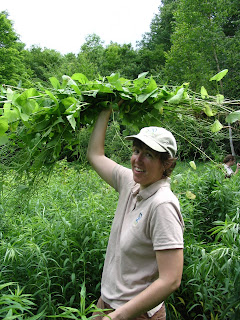Monday we returned to the Mt. Tabor workstation for another week of invasives surveying and mapping. Most of the longer trails were assessed last week, but a good amount of roads and spur trails remained. Throughout the week most of the crew headed out in Jazelle (our lovely van) to survey, while a few people stayed back to work in the office. With all the invasives data forms and GPS points coming in, some GIS and organizing work was in order, not to mention the drafting of our final reports for GMNF and South Burlington. We were successful in finishing up what roads/trails the GMNF wanted us to cover, and then moved on to other areas we thought were important to check out.
On Tuesday Kate Walker stopped by to drop off more NNIS forms and talk about how things were going. Then we headed out to look at more roads running through the GMNF. On the way back we stopped by the Manchester Ranger Station to say hi. Alex Sienkiewicz, the district Ranger, gave us a tour of the facility, introduced us to the people who worked there, and even gave us some tips on how to secure a job with the Forest Service. Thanks Alex!
On Wednesday in addition to more surveying and report work, we picked a large patch of garlic mustard at a trailhead off of Tower Rd in Dorset.
On the way back we stopped at the local cafe´ to congratulate ourselves on some hard work done...
mmmmm..... just like old times...
Later in the day we had a meeting with Melissa Reichert to go over what we had accomplished in the past week and a half. In addition to the NNIS data we collected, Melissa was interested in any bear and moose signs we had encountered that would indicate high quality habitat and corridors that were being used.
Thursday was dedicated to invasives pulling along Rt. 259, one of the most infested roads.
It was a very productive week. In addition to all the field work and making a lot of headway on our reports, we decided on what will be our final LANDS projects! These “small team projects” (STPs), are all affiliated with various land trusts, and will be undertaken by groups of three interns each. The land trusts we are working with are: The Lake Champlain Land Trust (LCLT), Jericho Underhill Land Trust (JULT), and the Nature Conservancy (TNC). Unlike our two previous projects, where the objectives had been determined at an earlier time, for the STPs the interns will be more involved in the planning process. During the week of the 29th LANDS groups will be meeting with our respective organizations to draft an official proposal and determine a work plan.
-The team working with the JULT will focus on a 125 acre parcel JULT has recently acquired that adjoins the Wolfrun property.
- The team working with the Nature Conservancy will focus on the Charlotte Wilderness and Recreation Park in Charlotte, VT.
-The team working with the LCLT group will be focused on the 57 acre Porter Natural Area in Colchester.
For more information on each of these organizations:
-LCLT: http://www.lclt.org/index.htm
-JULT: http://www.jult.org/
-TNC: http://www.nature.org/
We are all very exited about what great opportunities these projects hold. More info to follow...
Thanks for reading!



 (Andrea L. hard at work filling out a data sheet on invasive species)
(Andrea L. hard at work filling out a data sheet on invasive species)
 (Andrea B. removing common buckthorn)
(Andrea B. removing common buckthorn) (The LANDS team working at Mt. Tabor)
(The LANDS team working at Mt. Tabor)


















